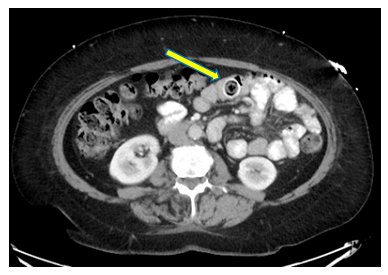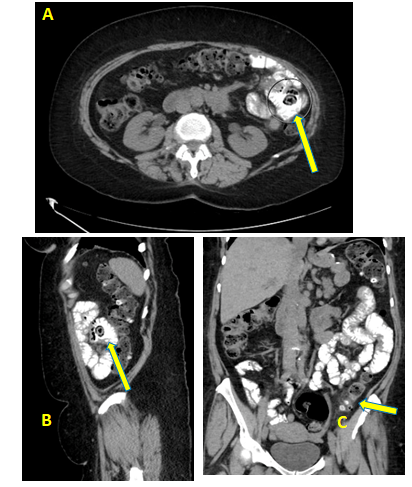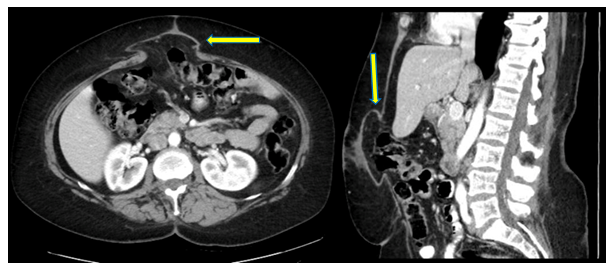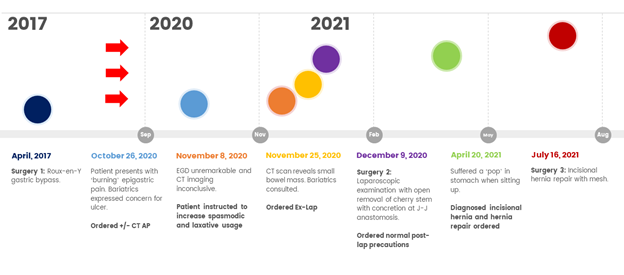Cherry Fruit-Stem Stapled into J-J anastomoses during Roux-en-Y Gastric Bypass: A Case Report of a Rare Complication
Logan D Glosser1*, Alexander Young1, Justin Smith1, Conner V Lombardi1, Abdullah Alalwan2, Motaz Al-yafi2, Stephen Stanek3
1University of Toledo College of Medicine and Life Sciences, Toledo, Ohio, USA
2University of Toledo College of Medicine, Department of General Surgery, Toledo, Ohio, USA
3Promedica Toledo Hospital, Department of General surgery, Toledo, Ohio, USA
*Corresponding Author: Logan D Glosser, University of Toledo College of Medicine and Life Sciences, Toledo, Ohio, USA
Received: 22 March 2022; Accepted: 29 March 2022; Published: 18 April 2022
Article Information
Citation: Logan D Glosser, Alexander Young, Justin Smith, Conner V Lombardi, Abdullah Alalwan, Motaz Al-yafi, Stephen Stanek. Cherry Fruit-Stem Stapled into J-J anastomoses during Roux-en-Y Gastric Bypass: A Case Report of a Rare Complication. Journal of Surgery and Research 5 (2022): 194-201.
View / Download Pdf Share at FacebookAbstract
Introduction
Roux-en-Y gastric bypass (RYGB) surgery is the gold standard intervention for weight loss in patients with morbid obesity. Although the mortality associated with the procedure is reduced compared to no intervention, complications account for a high percent of associated morbidity.
Case Presentation
A 63-year-old female with a history of laparoscopic RYGB 2 years prior presented with a 3-month history of crampy abdominal pain. A CT scan showed an intra-luminal mass near the jejunojejunostomy (JJ) site. Surgical excision of the mass revealed a stalk of tissue stapled into the JJ anastomosis that was identified as a cherry fruit-stem. Unfortunately, the patient returned 3 months later suffering from an incisional hernia, requiring mesh repair.
Discussion
RYGB is one of the most commonly performed procedures in bariatric surgery. Common complications from this that result in abdominal pain include anastomotic leaks or strictures, cholecystitis, gastrointestinal bleeding, internal herniation, and marginal ulceration. No prior literature discusses intermittent obstructive symptoms secondary to a foreign body anchored by the anastomotic staples. Furthermore, there are currently no universal dietary guidelines for patients in the immediate pre-operative period with regard to avoiding certain foods that could get stapled during the anastomotic construction.
Conclusion
There are two main take-away lessons from this case. First, this case denotes an unusual complication following RYGB surgery requiring surgical intervention in which the stem of a cherry fruit was stapled into the JJ anastomosis causing obstruction
Keywords
Roux-en-y gastric bypass, Anastomosis complications, Case report, Small bowel obstruction, Incisional hernia
Roux-en-y gastric bypass articles; Anastomosis complications articles; Case report articles; Small bowel obstruction articles; Incisional hernia articles
Roux-en-y gastric bypass articles Roux-en-y gastric bypass Research articles Roux-en-y gastric bypass review articles Roux-en-y gastric bypass PubMed articles Roux-en-y gastric bypass PubMed Central articles Roux-en-y gastric bypass 2023 articles Roux-en-y gastric bypass 2024 articles Roux-en-y gastric bypass Scopus articles Roux-en-y gastric bypass impact factor journals Roux-en-y gastric bypass Scopus journals Roux-en-y gastric bypass PubMed journals Roux-en-y gastric bypass medical journals Roux-en-y gastric bypass free journals Roux-en-y gastric bypass best journals Roux-en-y gastric bypass top journals Roux-en-y gastric bypass free medical journals Roux-en-y gastric bypass famous journals Roux-en-y gastric bypass Google Scholar indexed journals Anastomosis complications articles Anastomosis complications Research articles Anastomosis complications review articles Anastomosis complications PubMed articles Anastomosis complications PubMed Central articles Anastomosis complications 2023 articles Anastomosis complications 2024 articles Anastomosis complications Scopus articles Anastomosis complications impact factor journals Anastomosis complications Scopus journals Anastomosis complications PubMed journals Anastomosis complications medical journals Anastomosis complications free journals Anastomosis complications best journals Anastomosis complications top journals Anastomosis complications free medical journals Anastomosis complications famous journals Anastomosis complications Google Scholar indexed journals Small bowel obstruction articles Small bowel obstruction Research articles Small bowel obstruction review articles Small bowel obstruction PubMed articles Small bowel obstruction PubMed Central articles Small bowel obstruction 2023 articles Small bowel obstruction 2024 articles Small bowel obstruction Scopus articles Small bowel obstruction impact factor journals Small bowel obstruction Scopus journals Small bowel obstruction PubMed journals Small bowel obstruction medical journals Small bowel obstruction free journals Small bowel obstruction best journals Small bowel obstruction top journals Small bowel obstruction free medical journals Small bowel obstruction famous journals Small bowel obstruction Google Scholar indexed journals Incisional hernia articles Incisional hernia Research articles Incisional hernia review articles Incisional hernia PubMed articles Incisional hernia PubMed Central articles Incisional hernia 2023 articles Incisional hernia 2024 articles Incisional hernia Scopus articles Incisional hernia impact factor journals Incisional hernia Scopus journals Incisional hernia PubMed journals Incisional hernia medical journals Incisional hernia free journals Incisional hernia best journals Incisional hernia top journals Incisional hernia free medical journals Incisional hernia famous journals Incisional hernia Google Scholar indexed journals JJ anastomosis articles JJ anastomosis Research articles JJ anastomosis review articles JJ anastomosis PubMed articles JJ anastomosis PubMed Central articles JJ anastomosis 2023 articles JJ anastomosis 2024 articles JJ anastomosis Scopus articles JJ anastomosis impact factor journals JJ anastomosis Scopus journals JJ anastomosis PubMed journals JJ anastomosis medical journals JJ anastomosis free journals JJ anastomosis best journals JJ anastomosis top journals JJ anastomosis free medical journals JJ anastomosis famous journals JJ anastomosis Google Scholar indexed journals sleeve gastrectomy articles sleeve gastrectomy Research articles sleeve gastrectomy review articles sleeve gastrectomy PubMed articles sleeve gastrectomy PubMed Central articles sleeve gastrectomy 2023 articles sleeve gastrectomy 2024 articles sleeve gastrectomy Scopus articles sleeve gastrectomy impact factor journals sleeve gastrectomy Scopus journals sleeve gastrectomy PubMed journals sleeve gastrectomy medical journals sleeve gastrectomy free journals sleeve gastrectomy best journals sleeve gastrectomy top journals sleeve gastrectomy free medical journals sleeve gastrectomy famous journals sleeve gastrectomy Google Scholar indexed journals biliopancreatic diversion articles biliopancreatic diversion Research articles biliopancreatic diversion review articles biliopancreatic diversion PubMed articles biliopancreatic diversion PubMed Central articles biliopancreatic diversion 2023 articles biliopancreatic diversion 2024 articles biliopancreatic diversion Scopus articles biliopancreatic diversion impact factor journals biliopancreatic diversion Scopus journals biliopancreatic diversion PubMed journals biliopancreatic diversion medical journals biliopancreatic diversion free journals biliopancreatic diversion best journals biliopancreatic diversion top journals biliopancreatic diversion free medical journals biliopancreatic diversion famous journals biliopancreatic diversion Google Scholar indexed journals gastric outlet articles gastric outlet Research articles gastric outlet review articles gastric outlet PubMed articles gastric outlet PubMed Central articles gastric outlet 2023 articles gastric outlet 2024 articles gastric outlet Scopus articles gastric outlet impact factor journals gastric outlet Scopus journals gastric outlet PubMed journals gastric outlet medical journals gastric outlet free journals gastric outlet best journals gastric outlet top journals gastric outlet free medical journals gastric outlet famous journals gastric outlet Google Scholar indexed journals inconclusive imaging articles inconclusive imaging Research articles inconclusive imaging review articles inconclusive imaging PubMed articles inconclusive imaging PubMed Central articles inconclusive imaging 2023 articles inconclusive imaging 2024 articles inconclusive imaging Scopus articles inconclusive imaging impact factor journals inconclusive imaging Scopus journals inconclusive imaging PubMed journals inconclusive imaging medical journals inconclusive imaging free journals inconclusive imaging best journals inconclusive imaging top journals inconclusive imaging free medical journals inconclusive imaging famous journals inconclusive imaging Google Scholar indexed journals cholecystectomy articles cholecystectomy Research articles cholecystectomy review articles cholecystectomy PubMed articles cholecystectomy PubMed Central articles cholecystectomy 2023 articles cholecystectomy 2024 articles cholecystectomy Scopus articles cholecystectomy impact factor journals cholecystectomy Scopus journals cholecystectomy PubMed journals cholecystectomy medical journals cholecystectomy free journals cholecystectomy best journals cholecystectomy top journals cholecystectomy free medical journals cholecystectomy famous journals cholecystectomy Google Scholar indexed journals
Article Details
1. Case Report
1.1 Introduction
The obesity epidemic in the US is rampant, with approximately 42% of adults affected [1]. Despite global education and treatment with diet, exercise, and pharmaceutical management, bariatric surgery remains the most effective intervention for weight loss [2]. The current gold standard operation for weight loss is the laparoscopic Roux-en-Y gastric bypass (RYGB). RYGB provides safe and sustainable weight-loss in comparison to alternative approaches such as gastric banding, sleeve gastrectomy, and biliopancreatic diversion [3-5]. RYGB entails dividing the jejunum approximately 45 cm below the gastric outlet and anastomosing it to a 15-30 ml gastric pouch created from the proximal end of the stomach. The remaining stomach pouch with the 45 cm jejunal tail is re-anastomosed to the jejunum 75-150 cm below primary gastro-jejunal pouch [6]. RYGB has proven beneficial by improving insulin resistance, glycemic indices, and reducing excess weight by 50-75% [5-7]. Despite the benefits, there are well-characterized complications including marginal ulcers, gastric dilation, stomal stenosis, volvulus, internal hernia, and anastomotic complications among others [8]. Obstructive symptoms are typically vague (e.g., epigastric pain) and result in non-diagnostic physical exams and inconclusive imaging [9]. Due to these factors, laparoscopic examination or exploratory laparotomy is often necessary if the symptoms become burdensome to the patient. We present the rare case of a women who developed obstructive symptoms 2 years following her RYGB procedure. The patient was treated at an academic hospital with surgical intervention. A bezoar attached to a stalk of a cherry fruit-stem stapled into the JJ-anastomosis was found. This was managed with exploratory laparoscopy without need for reconsecration of the RYGB or resection of bowel.
1.2 Case Presentation
A 63-year-old female with past surgical history of a cholecystectomy with more recent gastric bypass 2 years prior presented with 3 months of crampy left upper quadrant pain and weight loss. One month prior, the patient had an ED visit for severe epigastric pain radiating to the chest and back. A CT of the abdomen and pelvis showed colonic diverticulosis without inflammation (figure 1).

Figure 1: CT scan read as unremarkable in work up at emergency department visit with mass found in retrospect.
Interval esophagogastroduodenoscopy showed no significant findings. The patient reported that bowel movements exacerbated the epigastric pain, with dicycloverine providing relieve. She had been taking MiraLAX ™ since the gastric bypass operation, although felt it had not been helping. On presentation, repeat CT of the abdomen wand pelvis revealed a mass in the bowel near the area of the jejunojejunostomy (JJ) (figure 2). In retrospect, the prior CT demonstrated a round lesion in the proximal small bowel about the size of an olive. The lesion was suspected to be stool due to some solid dense areas and some areas of air density. There was no air in the biliary tree with a common bile duct measuring 2 cm in diameter. This combined with the prior cholecystectomy made a gallstone unlikely. To determine the etiology of the mass and suspected cause of the symptoms the patient elected for a laparoscopy, with possible conversion to open, and planned excision of the mass. An incision was made just beneath the left costal margin through which a 5 mm Optiview port was introduced into the abdomen for insufflation with carbon dioxide. An 11 mm port was then placed to the right of the umbilicus, a 5 mm port placed below the right costal margin, and a 12 mm port placed along the right of the mid-abdomen. The stomach and small bowel were thoroughly explored with particular attention of the GJ anastomosis, the JJ, biliopancreatic limb and the entire common channel down to the ileocecal valve. No masses were appreciated with this manipulation. It was decided to examine the bowel directly. A clamp was placed onto the area of the JJ laparoscopically. A midline incision about 6 cm in length with dissection through 5 cm of subcutaneous fat was made. The midline fascia was opened and the peritoneal cavity was entered. The JJ was elevated to this incision, grasped with a Babcock, and pulled out of the abdomen. With blunt examination a mass attached to a narrow stalk and downward mobility was palpable through the abdominal wall just beyond the JJ in the common channel. An anti-mesenteric incision 2 cm in length was made and we encountered a yellowish-brown structure that crumbled on gross palpation with the particulate matter subsequently suctioned out. Upon removal, a stalk was still present which was followed down to its base and excised. Further inspection revealed that the stalk was stapled into the tissue of the J-J anastomosis. A staple application used to create the JJ during the bariatric operation that passed across a cherry stem. Thus, this stem was unable to move down the bowel and was the nidus for a concretion of material. This lesion would intermittently be caught by bowel contractions and lead to crampy, abdominal pain. On post-operative day 1 she was tolerating liquids, passing flatus, ambulating well. She had not requested or received anything for pain other than Tylenol. The post-operative course was unremarkable and thus she was discharged home that afternoon. In the following months the patient developed an anterior abdominal bulge protruding along the midline. Although the patient was satisfied with the treatment of the anastomotic blockage, follow up CT displayed an incisional hernia (figure 3), requiring surgical repair with mesh.

Figure 2: CT scan images identifying obstructive mass (A - axial, B - sagittal, C - coronal).

Figure 3: CT Scan demonstrating incisional hernia status post-anastomotic repair.

Figure 4: Timeline of events from initial Roux-en-Y gastric bypass to incisional hernia repair with mesh.
2. Discussion
Anastomotic complications after RYGB surgery, although rare, can be a cause of significant morbidity in patients [10]. Anastomotic complications are divided into early (within the first 2 weeks of the procedure) and late (greater than 2 weeks). Early complications include anastomotic leak, bleeding, and edema, whereas late complications include strictures, ulcers, obstruction and internal hernias [11]. Our patient developed late complications of SBO secondary to intermittent anastomotic herniation. The nonspecific presentations of the various RYGB complications make for a challenging diagnosis, even for the astute surgeon. Increased gallstone formation following rapid and massive weight loss in bariatric surgery is well documented. As such, gallstone complications of acute cholecystitis or cholangitis is a common source of nonspecific abdominal pain after bariatric surgery [12]. However, our patient had already undergone cholecystectomy several years prior to her RYGB procedure. The nature and timeline of her cholecystectomy without laboratory findings of hepato-biliary obstruction made acute cholecystitis or retained gallstone unlikely. Small bowel obstructions (SBO) after RYGB are an uncommon, but well-characterized post-operative complication. One study reported that SBOs occurred in 3.8% of patients after RYGB, with adhesions and internal herniations accounting for more than 60% of obstructions [13]. When SBOs do occur, they typically present more than 1 month after the operation, although it can appear years later as seen in our patient. Common etiologies of SBO after gastric bypass include intussusception, internal hernia, hemorrhagic bezoar, and adhesions [14]. The cause of obstruction differs by surgical approach: laparoscopic RYGB is more likely to have obstruction at the JJ site, while adhesive small bowel obstruction is more common following the open approach [10]. This is likely secondary to the inherent differences between open and laparoscopic surgery, as an open approach predisposes to more adhesions which act as the body’s natural defense in preventing intestinal herniation through mesenteric defects [15]. If an obstruction is significant enough to necessitate treatment through bowel resection or restructuring of the JJ anastomosis, patients have significantly worse outcomes [10]. Through the laparoscopic approach, our patient had a partial SBO at the JJ site, in line with the statistical predictability. Three months following the surgical excision of the cherry stem stapled in the JJ anastomosis, the patient developed an incisional hernia. Incisional hernias are reported to occur in 1% of patients after any open abdominal surgery [16]. Our patient then required a third operation to repair the incisional hernia with mesh. Dietary recommendations prior to bariatric surgery vary by institution and no universal guidelines currently exist [17]. Some guidelines specify a liquid-only diet for 1-2 weeks, [17] whereas other institutions recommend having only 1 meal per day with solid food [18]. Regardless of the specific recommendations, there is not an official list of foods that should be avoided preoperatively. Our case suggests that bariatric surgeons provide a specific list of foods to avoid if taking solid foods, or that patients should adhere to the 2 weeks of liquid only diet.
3. Conclusion
This case demonstrates an unusual etiology of abdominal pain following RYGB: SBO at the JJ site following the inadvertent introduction of a cherry stem into the anastomotic stapling. This stem then acted as a nidus for the development of a bezoar which intermittently obstructed the small intestine at the distal alimentary limb. Early diagnosis and surgical exploration in suspected cases can provide immediate relief and limit the suffering of patients, although it also exposes patients to increased risk of surgical complications. Our case has 2 primary lessons from which to learn. First, surgeons need to be aware of the potential complication of non-digestible food impaction at the anastomotic sites. Second, there is a need for standardized dietary guidelines for the 2-week pre-operative period. This case suggests that patients should adhere to a liquid diet leading up to the surgery to avoid inadvertent stapling of non-digestible foods.
Consent
Written patient informed consent was obtained with signature.
Conflict of interest statement
The authors have declared no conflicts of interest.
References
- Adult Obesity Facts CDC.gov: USA.gov 2017-2018.
- O'Brien PE, McPhail T, Chaston TB, et al. Systematic review of medium-term weight loss after bariatric operations. Obes Surg 16 (2006): 1032-1040.
- Osland E, Yunus RM, Khan S, et al. Late Postoperative Complications in Laparoscopic Sleeve Gastrectomy (LVSG) Versus Laparoscopic Roux-en-y Gastric Bypass (LRYGB): Meta-analysis and Systematic Review. Surg Laparosc Endosc Percutan Tech 26 (2016): 193-201.
- Li JF, Lai DD, Lin ZH, et al. Comparison of the long-term results of Roux-en-Y gastric bypass and sleeve gastrectomy for morbid obesity: a systematic review and meta-analysis of randomized and nonrandomized trials. Surg Laparosc Endosc Percutan Tech 24 (2014): 1-11.
- DeMaria EJ, Pate V, Warthen M, et al. Baseline data from American Society for Metabolic and Bariatric Surgery-designated Bariatric Surgery Centers of Excellence using the Bariatric Outcomes Longitudinal Database. Surg Obes Relat Dis 6 (2010): 347-355.
- Seeras K, Acho RJ, Lopez PP. Roux-en-Y Gastric Bypass Chronic Complications. Stat Pearls. Treasure Island (FL), (2021).
- Rubino F, Kaplan LM, Schauer PR, et al. The Diabetes Surgery Summit consensus conference: recommendations for the evaluation and use of gastrointestinal surgery to treat type 2 diabetes mellitus. Ann Surg 251 (2010): 399-405.
- Mustafa W, Aman MKES MD, Thomas H Magnuson, et al. Intestinal Complications after Roux-en-Y Gastric Bypass. Bariatric Times 12 (2015): 14-18.
- Elkbuli A, Santarone K, Kinslow K, et al. A rare case of internal hernia, intussusception and volvulus following gastric bypass: A case report and literature review. Int J Surg Case Rep 67 (2020): 178-182.
- Nelson LG, Gonzalez R, Haines K, et al. Spectrum and treatment of small bowel obstruction after Roux-en-Y gastric bypass. Surg Obes Relat Dis 2 (2006): 377-383.
- Silecchia G, Iossa A. Complications of staple line and anastomoses following laparoscopic bariatric surgery. Ann Gastroenterol 31 (2018): 56-64.
- Karadeniz M, Gorgun M, Kara C. The evaluation of gallstone formation in patients undergoing Roux-en-Y gastric bypass due to morbid obesity. Ulus Cerrahi Derg 30 (2014): 76-79.
- Elms L, Moon RC, Varnadore S, et al. Causes of small bowel obstruction after Roux-en-Y gastric bypass: a review of 2,395 cases at a single institution. Surg Endosc 28 (2014): 1624-1628.
- Rogula T, Yenumula PR, Schauer PR. A complication of Roux-en-Y gastric bypass: intestinal obstruction. Surg Endosc 21 (2007): 1914-1918.
- Champion JK, Williams M. Small bowel obstruction and internal hernias after laparoscopic Roux-en-Y gastric bypass. Obes Surg 13 (2003): 596-600.
- Adotey JM. Incisional hernia: a review. Niger J Med 15 (2006): 34-43.
- Bettini S, Belligoli A, Fabris R, et al. Diet approach before and after bariatric surgery. Rev Endocr Metab Disord 21 (2020): 297-306.
- Ward L. Pre Bariatric Surgery Diet: information for patients (2010).


 Impact Factor: * 4.2
Impact Factor: * 4.2 Acceptance Rate: 72.62%
Acceptance Rate: 72.62%  Time to first decision: 10.4 days
Time to first decision: 10.4 days  Time from article received to acceptance: 2-3 weeks
Time from article received to acceptance: 2-3 weeks 